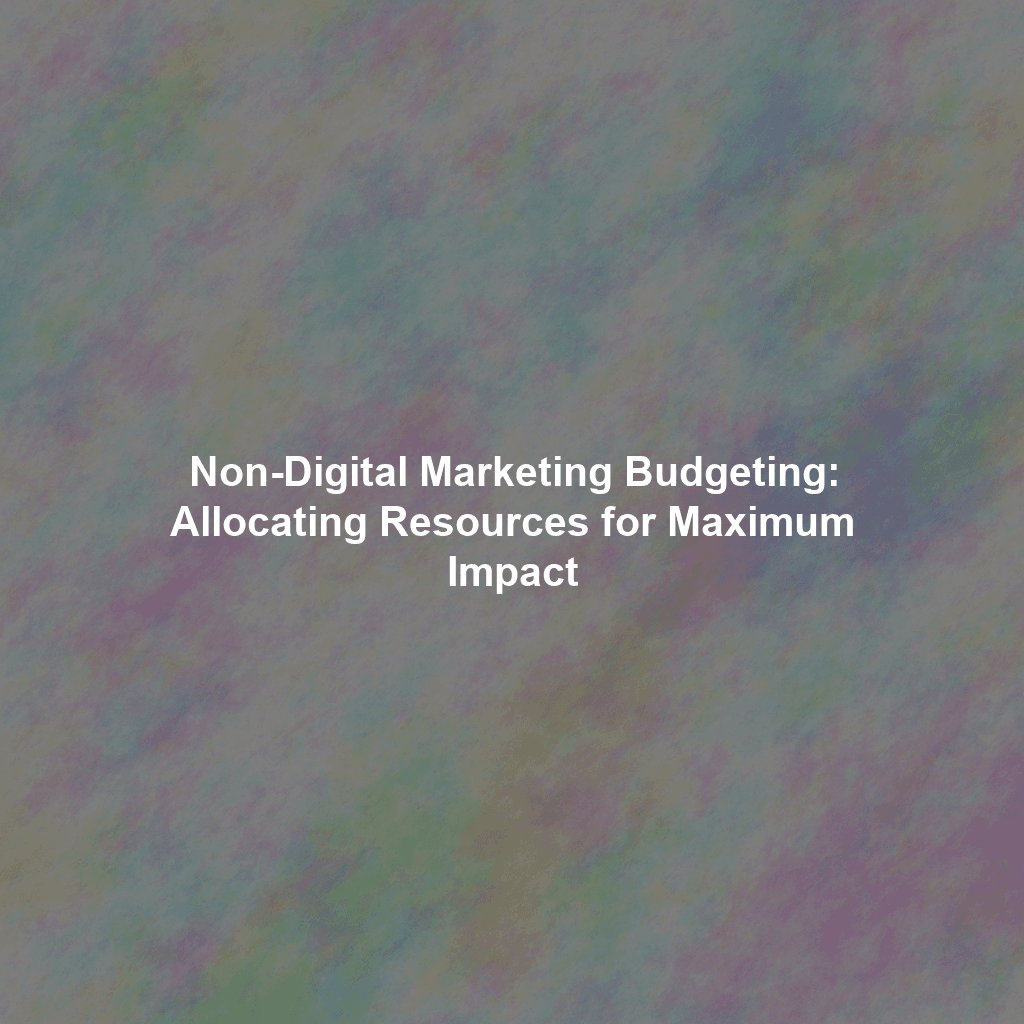In today’s digital-first world, it’s easy to overlook the enduring power of non-digital marketing. While online strategies dominate headlines, a well-executed offline campaign can cut through the noise and forge deeper, more tangible connections with your target audience. However, success hinges on strategic budget allocation. This guide will provide you with a framework for effectively distributing your non-digital marketing budget to achieve maximum impact and a strong return on investment.
Understanding Your Non-Digital Marketing Landscape
Before diving into budget specifics, it’s crucial to understand the various non-digital marketing channels available and how they can contribute to your overall marketing goals. Consider these options:
- Print Advertising: Newspapers, magazines, brochures, flyers.
- Direct Mail Marketing: Postcards, letters, catalogs.
- Event Marketing: Trade shows, conferences, workshops, local events.
- Out-of-Home (OOH) Advertising: Billboards, posters, transit advertising.
- Public Relations (PR): Media relations, press releases, community engagement.
- In-Store Marketing: Point-of-sale displays, signage, promotions.
Defining Your Target Audience and Goals
Just like any marketing initiative, successful non-digital budgeting starts with a clear understanding of your target audience and your desired outcomes. Ask yourself:
- Who are you trying to reach? (Demographics, psychographics, behavior)
- What are your primary marketing goals? (Brand awareness, lead generation, sales increase, customer loyalty)
- What is your overall marketing budget, and what percentage is allocated to non-digital channels?
Answering these questions will help you prioritize channels and allocate resources effectively. For example, if you’re targeting senior citizens, direct mail might be a more effective option than social media advertising. If your goal is to generate leads at a trade show, investing in an engaging booth and well-trained staff is paramount.
Allocating Your Budget Strategically
Once you have a solid understanding of your target audience and goals, you can begin to allocate your budget. Here’s a framework to guide you:
Prioritize Based on ROI Potential
Not all non-digital channels offer the same return on investment (ROI). Analyze the potential ROI of each channel based on your past experiences (if any), industry benchmarks, and market research. Consider factors like reach, engagement, conversion rates, and cost per acquisition (CPA). Focus on channels with the highest potential for delivering your desired results.
Consider Your Brand Identity and Messaging
Your non-digital marketing efforts should align seamlessly with your overall brand identity and messaging. Choose channels that best reflect your brand values and resonate with your target audience. For example, a luxury brand might prioritize high-end print advertising and exclusive events, while a budget-friendly brand might focus on local community events and direct mail promotions.
Factor in Production Costs and Lead Times
Non-digital marketing often involves significant production costs, such as printing, design, booth construction, and material sourcing. Be sure to factor these costs into your budget, as they can significantly impact your overall ROI. Additionally, consider the lead times required for each channel. Print advertising, for example, often requires several weeks of preparation, while event marketing may require months of planning.
Allocate Budget for Measurement and Tracking
While non-digital marketing can be more challenging to track than digital, it’s still essential to measure your results. Allocate a portion of your budget for tools and methods to track key metrics, such as:
- Website traffic from print ads: Use vanity URLs or QR codes.
- Lead generation from direct mail: Include unique offer codes or tracking phone numbers.
- Booth traffic and lead capture at events: Use lead scanners or manual data entry.
- Media mentions and reach from PR efforts: Track media coverage and estimate audience reach.
Analyzing these metrics will help you optimize your campaigns and improve your ROI over time.
The Importance of Testing and Iteration
Don’t be afraid to experiment with different channels and approaches. Allocate a small portion of your budget for testing new ideas and iterating on existing campaigns. For example, you could test different direct mail formats or event booth layouts to see what performs best. Continuous testing and iteration will help you refine your non-digital marketing strategy and maximize your ROI.
Example Budget Allocation Scenario
Let’s say you have a non-digital marketing budget of $50,000. Here’s a potential allocation:
- Event Marketing (Trade Show): $20,000 (Booth space, design, staffing, travel)
- Direct Mail Marketing: $15,000 (Design, printing, postage)
- Print Advertising (Local Newspaper): $5,000 (Ad placement)
- Public Relations: $5,000 (Press release distribution, media outreach)
- Measurement and Tracking: $5,000 (Tracking phone numbers, QR code generation, lead capture software)
This is just an example, of course. Your specific allocation will depend on your individual goals, target audience, and ROI potential.
Conclusion
Effective non-digital marketing budgeting requires careful planning, strategic allocation, and continuous measurement. By understanding your target audience, prioritizing channels based on ROI potential, and allocating resources for measurement and tracking, you can maximize the impact of your offline campaigns and achieve your marketing goals. Don’t underestimate the power of non-digital marketing to connect with your audience on a deeper level and drive real business results. Remember to always test, iterate, and adapt your strategy to stay ahead of the curve and optimize your return on investment.


